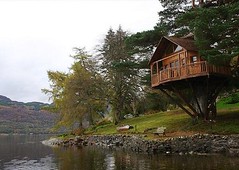Here are some tips for implementing a green lifestyle at home.
The Kitchen
 |
| (Photo credit: Wikipedia) |
* Save water in the kitchen by not pre-rinsing dishes and only running the dishwasher when it's full. If you have to pre-rinse (some dishwashers just can't handle non-rinsed dishes), then do so in a sink half-full of water. Scrub and rinse with the water off, and then load the dishwasher. You've only used half a sinkful of water to pre-rinse. You can also save water in the kitchen by washing produce in a pan of water.
* Appliance use is heavy in the kitchen, from the refrigerator to the stovetop. To save energy, you can combine the cooking of foods by baking more than one thing at the same time. On the stovetop, use residual heat where you can and place pots and pans on appropriately-sized stove eyes.
If possible, use energy-efficient appliances in the kitchen. And your parents were right - don't hold the refrigerator door open!
The Bedroom
In your bedroom, you can go green in some different ways.
* Use natural bedding such as cotton sheets without a lot of heavy dyes and deep colors.
* Place air-cleaning potted plants around your bedroom to purify the air. In kids' bedrooms, potted plants can also be implemented as long as they are out of reach of young children.
The Living Room
In your main living space, you can go green by using fans to cool the room in the summer and a space heater to boost the central heat in the winter. You can also:
* Set potted plants around for cleaner air.
* Cover windows with shades or curtains to keep out hot sunshine in the summer, and open them in the winter to help warm the room.
* Make use of natural light as much as possible. Position reading chairs and couches so that window light comes from behind, over the reader's shoulder. Use small lamps with CFLs and timers.
Peripheral Rooms
In rooms that are not being used, close vents to keep down heating and cooling costs and energy use. Make sure sunshine is not heating these rooms in the summer, and apply the same principle in reverse in the winter.
These are just some simple tips that you can use to live a greener lifestyle without spending any money at all! If you have other ideas, please comment below and share your tips!










